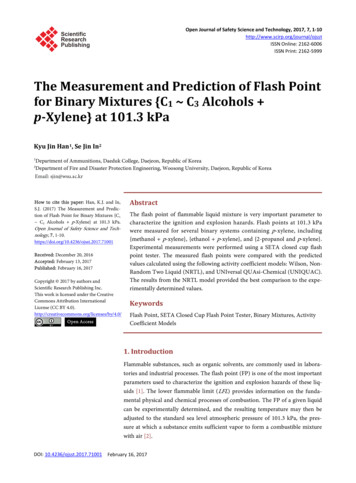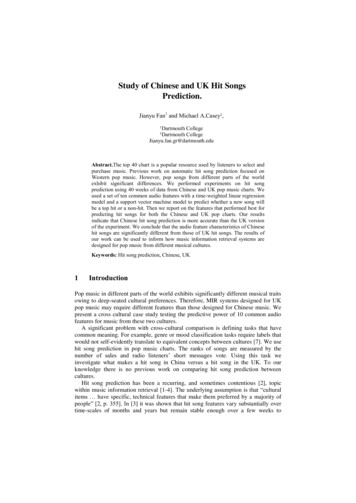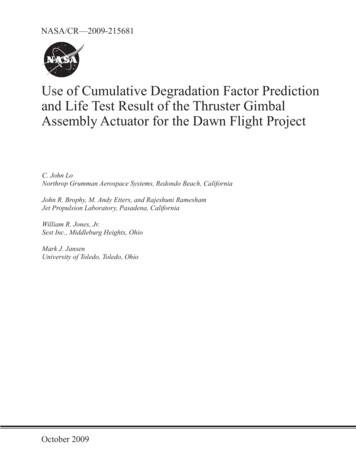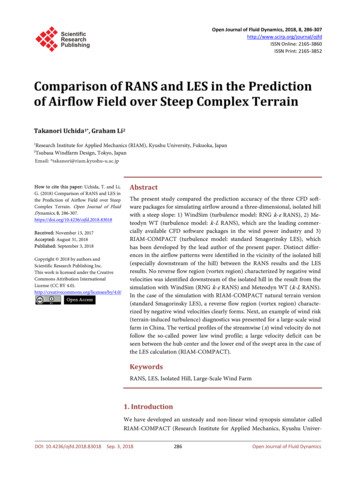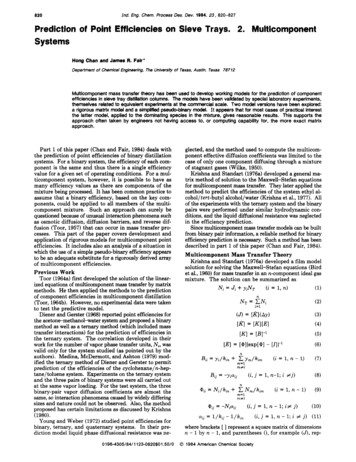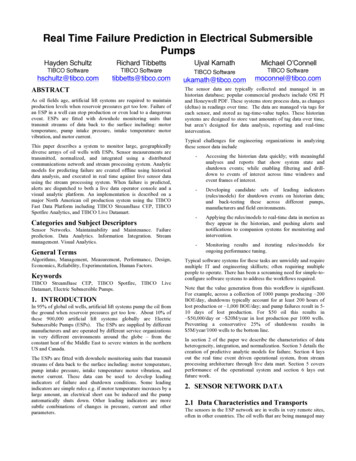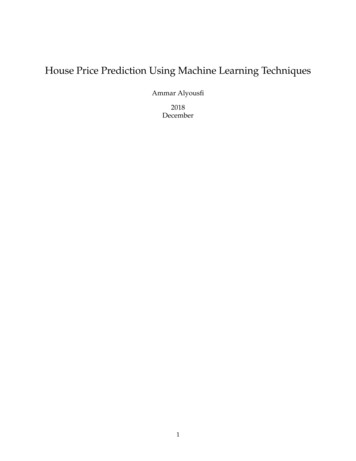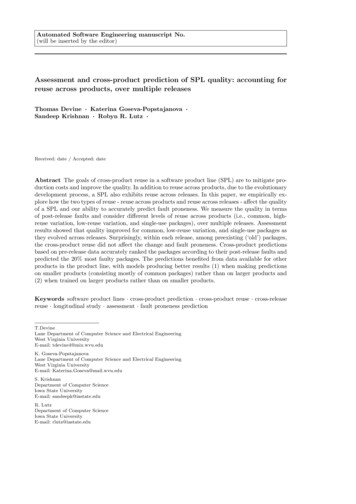
Transcription
Automated Software Engineering manuscript No.(will be inserted by the editor)Assessment and cross-product prediction of SPL quality: accounting forreuse across products, over multiple releasesThomas Devine · Katerina Goseva-Popstajanova ·Sandeep Krishnan · Robyn R. Lutz ·Received: date / Accepted: dateAbstract The goals of cross-product reuse in a software product line (SPL) are to mitigate production costs and improve the quality. In addition to reuse across products, due to the evolutionarydevelopment process, a SPL also exhibits reuse across releases. In this paper, we empirically explore how the two types of reuse - reuse across products and reuse across releases - affect the qualityof a SPL and our ability to accurately predict fault proneness. We measure the quality in termsof post-release faults and consider different levels of reuse across products (i.e., common, highreuse variation, low-reuse variation, and single-use packages), over multiple releases. Assessmentresults showed that quality improved for common, low-reuse variation, and single-use packages asthey evolved across releases. Surprisingly, within each release, among preexisting (‘old’) packages,the cross-product reuse did not affect the change and fault proneness. Cross-product predictionsbased on pre-release data accurately ranked the packages according to their post-release faults andpredicted the 20% most faulty packages. The predictions benefited from data available for otherproducts in the product line, with models producing better results (1) when making predictionson smaller products (consisting mostly of common packages) rather than on larger products and(2) when trained on larger products rather than on smaller products.Keywords software product lines · cross-product prediction · cross-product reuse · cross-releasereuse · longitudinal study · assessment · fault proneness predictionT.DevineLane Department of Computer Science and Electrical EngineeringWest Virginia UniversityE-mail: tdevine4@mix.wvu.eduK. Goseva-PopstajanovaLane Department of Computer Science and Electrical EngineeringWest Virginia UniversityE-mail: Katerina.Goseva@mail.wvu.eduS. KrishnanDepartment of Computer ScienceIowa State UniversityE-mail: sandeepk@iastate.eduR. LutzDepartment of Computer ScienceIowa State UniversityE-mail: rlutz@iastate.edu
2Thomas Devine et al.1 IntroductionIn software engineering today, a widely used approach to reuse is through development of aSoftware Product Line (SPL), which explicitly defines the common and variable componentspresent in a family of systems (Gomaa, 2004). Weiss and Lai (1999) define a SPL as, “a family ofproducts designed to take advantage of [their] common aspects and predicted variabilities”. Thegoal of SPL engineering is to develop diverse families of software products and software-intensivesystems in shorter time, at lower cost, and with higher quality (Pohl et al, 2005). While therehave been several studies showing the benefits of systematic reuse across applications (Lim, 1994;Thomas et al, 1997; Frakes and Succi, 2001; Selby, 2005), empirical studies exploring these benefitsin the context of SPLs are lacking.In this paper we present a longitudinal study of the quality of products in a SPL. The study isbased on a subset of the Eclipse family of products, which has been previously studied by Chasteket al (2007) and van der Linden (2009) as a SPL. The central concepts of SPL engineering are:(1) the use of a collection of reusable artifacts and (2) in order to provide mass customization(Pohl et al, 2005). Eclipse demonstrates the first concept in its management and reuse of bothcommon and variable components across products. Eclipse demonstrates the second concept inits introduction of new products customized to the needs of its various user communities.Specifically, our study examines four products from the Eclipse project, Classic, C/C , Java,and JavaEE, through multiple releases. In the early releases Eclipse was developed and used as asingle platform for providing tools to aid software developers. The platform could be customizedto an individual developer’s interests by incorporating specific tool suites as plugins. Startingwith the release codenamed Europa, Eclipse evolved from a single, all-encompassing product intoa true product line by providing separate products which were already customized to specific userrequirements. These products contain shared code reused across multiple products. It appearsthat reuse across products in both open source and industrial SPLs is not ‘all or nothing’. Rather,while some components are reused across all products (so called commonalities), other componentsare reused only in a subset of products referred to as high-reuse variation and low-reuse variationcomponents in this paper. Products in a SPL also have single-use components that are used onlyin one product.It is important to note that a SPL exhibits two types of reuse, as illustrated in Figure 1. Reuseacross releases, represented on the x-axis in Figure 1, exists in all software systems developed ina release-oriented fashion and represents the evolution of an individual product across releases, asnew functionality is added or improvements are made over time. Reuse across products, representedby the y-axis in Figure 1, is typical for SPLs and represents the reuse of individual packages intwo or more products within the same release.The first part of our study focuses on assessing how reuse, both across releases and acrossproducts, affects the quality of a SPL. For this purpose, we focus on four distinct Eclipse productslongitudinally across seven releases and measure quality in terms of the number of post-releasefaults1 . We specifically explore different levels of reuse across products, over multiple releases,which provides SPL developers with insights into the utility of product lines and how the twodimensions of reuse affect the quality of SPL products. With respect to the quality assessment ofthe SPL we address the following research questions:RQ1: Does quality, measured by the number of post-release faults for the packages in each release,consistently improve as the SPL evolves across releases?RQ2: Do packages at different levels of reuse across products mature differently across releases?Does the quality of products benefit from reusing packages in multiple members of the SPL?1 A fault is defined as an accidental condition, which if encountered, may cause the system or system componentto fail to perform as required. We avoid using the term defect, which is used inconsistently in the literature to referin some cases to both faults and failures and in other cases only to faults or perhaps, faults detected pre-release.
Assessment and cross-product prediction of SPL quality3Fig. 1: An illustration of the two types of reuse (i.e., reuse across releases and reuse across products)in EclipseThe second part of our study focuses on prediction of post-release faults in members of theproduct line using models built on previous releases. Specifically, we built generalized linear regression models from each individual member of the product line family, then used them to rankthe packages in each product in the subsequent release by the number of post-release faults theyare likely to contain. This cross-product prediction approach allowed us to explore whether thepredictions for individual products benefit from available data for other members of the productline. This is a unique aspect of our work, which is especially important because it allows predicting the post-release fault proneness of new emerging products in the SPL, before they arereleased. The following research questions are devoted to the prediction of post-release faults frompre-release data:RQ3: Can we accurately predict which packages will contain a high percentage of the total postrelease faults from pre-release data using models built on the previous release?RQ4: Do the predictions of the most fault prone packages benefit from the data available for otherproducts? In other words, do cross-product predictions improve the accuracy?RQ1 can be viewed as conceptual replications of similar research question explored in non-SPLcontext by several works (Fenton and Ohlsson, 2000; Ostrand and Weyuker, 2002; Ostrand et al,2004; Khoshgoftaar and Seliya, 2004), and in only one study of a much smaller SPL (Mohagheghiand Conradi, 2008). Replicated studies, both exact and conceptual, are vital to empirical softwareengineering because they enable the software engineering community to explore the conditionsrequired to obtain specific results and to determine the external validity of results (Shull et al,2008). RQ2 is relevant only in a SPL context. The first part of this question furthers the preliminaryinvestigation of our previous work (Krishnan et al, 2011a) by explicitly exploring different levelsof cross-product reuse over multiple releases, including statistical tests of significance. The secondpart of RQ2 was not explored previously, including our previous work (Krishnan et al, 2011a).RQ3 and RQ4, which are focused on the effects of the reuse across products on cross-productpredictions of fault proneness, are explored for the first time in this paper.The main contributions of this study are:– In addition to reuse across releases, which is typical for any evolving software system, weexplored reuse across members of a SPL and how these two different types of reuse affectproducts’ quality and our ability to make accurate predictions. A unique characteristic of thiswork is our focus on the way packages are grouped in individual products, which allows us tomake predictions for emerging products, even before they are released for the first time. Thus,we were able to predict the fault proneness of the products C/C , Java, and Java EE, whichwere introduced in the Europa release of Eclipse (see Figure 1), based on the model built onthe product Classic from the previous release, 3.0.
4Thomas Devine et al.– The assessment results showed that as the product line continued to evolve through releases,previously existing (i.e., ‘old’) common packages, high-reuse variation packages and low-reusevariation packages remained prone to changes; only single-use packages experienced decreasingchange proneness as they evolved, perhaps because they were not affected by changes madeto other products. ‘Old’ common packages, low-reuse variation packages, and single-use packages improved in quality (measured by their post-release fault density) as they evolved acrossreleases, despite exhibiting significant change proneness. Previously existing high-reuse variation packages, however, did not exhibit an improvement in quality. Surprisingly, the level ofcross-product reuse (i.e., common, high-reuse variation, low-reuse variation and single-use)did not affect the change and fault proneness of ‘old’ packages within each release. Newly developed low-reuse variation packages tended to have higher post-release fault densities thaneither single-use packages or the common package, but the sample size of newly developedpackages was too small to draw strong conclusions.– A novel aspect of this research is the exploration of the benefit of using data from other productsin the SPL in support of fault proneness predictions. Specifically, we built models from theindividual products in each release and then used these models to make predictions for eachproduct in the subsequent release. Overall, we built 15 models, which were used to makecross-product predictions for a total of 54 combinations of products and releases.– The predictions were based on a generalized linear regression model with an ordered multinomial distribution and cumulative negative log-log linking function, which is specifically appropriate for skewed distributions characterized by higher probabilities of lower or zero values, asis typical for the distributions of post-release faults across software units (i.e., files, components, or packages). Models built on the previous release were used to predict the post-releasefault proneness of the following release. This approach mimics the actual data collection process and thus has more practical value than using cross-validation or bootstrapping. Thesemodels were used to predict the 20% most faulty packages, as well as to rank software packagesbased on the number of post-release faults they contain. Compared to binary classification ofpackages as fault-prone or not, this type of prediction conveys more information that is usefulfor determining effort required to repair faulty packages, which in turn may allow for moreefficient allocation of verification and validation resources.– The prediction results showed that models built from the data of one release could accuratelypredict the most fault prone packages in a subsequent release from that release’s pre-releasedata. Furthermore, rankings of fault prone packages created by our models were positively correlated to the actual rankings. The most interesting finding from the product line perspective isthat the best predictive models for each product were built from pre-release data that includedother products. This means that the predictions benefited from the use of data available forother products. Specifically, models built from larger products with more variability typicallyproduced better predictions than models built on the smaller products, which mainly consisted of common packages. Furthermore, all models achieved their best results when makingpredictions on smaller products.– We synthesized the findings of this study with the observations made in our previous workbased on a smaller industrial SPL with goal of identifying the trends, both in assessment andprediction of SPL quality, that are invariant across multiple product lines.The remainder of this paper is organized as follows. Section 2 presents related work. Section 3describes the Eclipse product line case study. Section 4 defines our metrics and discusses theprocess of their extraction, while Section 5 details our machine learning approach for creating andevaluating predictive models. The results on assessment of product line quality are presented inSection 6, followed by the results of the predictive analysis in Section 7. Section 8 offers a synthesisof the results from this study and our previous work based on an industrial SPL. Section 9 describesthe threats to validity, and Section 10 provides a summary of the main results and concludingremarks.
Assessment and cross-product prediction of SPL quality52 Related WorkWe first summarize the related work on numerical fault prediction not in SPLs. Then, we presentprior work on assessment and prediction (including classification and numerical prediction) in thecontext of SPLs. We end the section with a summary of the main contributions of this paper.2.1 Numerical prediction of post-release software faultsSeveral works in the literature have constructed and tested numerical models for fault prediction,with the aim of predicting the number of faults at a unit level (e.g., file, component, package)rather than providing a binary classification of whether the unit is fault-prone or not2 .Of these papers, four have used Eclipse as a case study (D’Ambros et al, 2009, 2010; Kameiet al, 2010; Zimmermann et al, 2007). It should be noted that none of them considered the SPLaspects of Eclipse. Rather, they analyzed collections of files and/or packages in several releases ofEclipse. In particular, D’Ambros et al (2009) used generalized linear models to explore the utilityof change coupling metrics for predicting post-release faults and to compare predictive techniqueson four different Eclipse components (D’Ambros et al, 2010). Both D’Ambros et al (2009) andD’Ambros et al (2010) used n-fold cross validation within a single data set to arrive at their finalresults. Kamei et al (2010) used linear regression, regression tree, and random forest models topredict post-release faults in three components of Eclipse. Experimental data showed that fusionperformed after making file-level predictions provided slightly better results than aggregating filelevel static code and process metrics to make predictions on the package-level. The results werevalidated by both a fifty-fifty split, where training was performed on half of the data and themodel was tested on the other half, and by building models on one release and predicting on thenext. Zimmermann et al (2007) used linear regression models on both file and package levels toperform a ranking from most to least faulty file and package, respectively. Models were built foreach of three releases of Eclipse (2.0, 2.1, and 3.0) and tested on all three releases.Numerical, post-release fault prediction studies of other software products not related toEclipse include (Bibi et al, 2006; Kastro and Bener, 2008; Khoshgoftaar and Munson, 1990; Liet al, 2006; Nagappan et al, 2006; Ostrand et al, 2004, 2005, 2010; Bell et al, 2006; Weyuker et al,2008; Shin et al, 2009).Bibi et al (2006) compared twelve different models to determine the benefits of regressionvia classification. Results were validated using n-fold cross validation. Static code metrics werecombined with change metrics by Kastro and Bener (2008) to create neural network predictionmodels for Linux. Khoshgoftaar and Munson (1990) used complexity metric features selectedby stepwise regression or factor analysis to compare linear regression models which predictedfault densities. Li et al (2006) also used linear regression and neural network models, as well asclustering, tree, and moving average models built from previous releases to predict the numberof faults in the next release. The models were constructed from source code, change, deployment,and usage metrics. Nagappan et al (2006) built logistic regression models from static code metricsalone on the module level and made predictions within a single project and across five differentMicrosoft projects (Internet Explorer 6, IIS W3 Server Core, Process Messaging Component,DirectX, and NetMeeting).The remaining studies all used negative binomial regression model on different software systemsto predict fault-proneness and validated their results by building models on one or all previousreleases, then making predictions on the next. Ostrand et al (2004) and Ostrand et al (2005)built models from file level information on LOC, number of previous faults, and change metrics.Bell et al (2006) compared the predictive ability of several negative binomial models built usingdifferent combinations of LOC and change metrics on the data extracted from an automated2 For a comprehensive survey of binary classification studies the reader is referred to the recent paper by Hallet al (2012).
6Thomas Devine et al.voice response system. A primary focus of the work by Weyuker et al (2008) was to investigatethe impact of the number of developers to the accuracy of predictions. The results showed thatthe metrics related to the number of developers led to “no more than a modest improvementin the predictive accuracy”. Ostrand et al (2010) also used negative binomial regression modeland explored whether including information about individual developers can be used to improvethe predictions. The results showed that the individual developer’s past performance was notan effective predictor of future bug locations. Shin et al (2009) used different combinations ofLOC, static code metrics, change metrics, faults from previous releases, and calling structureinformation to construct negative binomial regression models. It appeared that the addition ofcalling structure information to a model based solely on non-calling structure code attributesprovided noticeable improvement in prediction accuracy, but only marginally improved the bestmodel based on history (i.e., change) and non-calling structure code attributes.2.2 Assessment and prediction in a SPL contextLarge, industrial product lines rarely provide data for aca
In the early releases Eclipse was developed and used as a single platform for providing tools to aid software developers. The platform could be customized to an individual developer’s interests by incorporating specific tool suites as plugins. Starting with the release codenamed Europa, Eclipse
